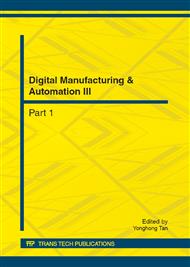[1]
Hirose Takashi, Fan Tongxiang, Okabe Toshihiro, et al. Effect of carbonizing speed on the property changes of woodceramics impregnated with liquefacient wood. Materials. Letters. 2002, 52: 229-233.
DOI: 10.1016/s0167-577x(01)00399-8
Google Scholar
[2]
Iizuka Hiroshi, Fushitani Masami, Okabe Toshihiro, et al. Mechanical Properties of Woodceramics: A Porous Carbon Material. Journal of Porous Materials. 1999, 6: 175-184.
DOI: 10.1007/bf00488112
Google Scholar
[3]
Sun Delin, Yu Xianchun, Liu Wenjin, et al. Effects of sintering conditions on microstructure changes of wood-ceramics impregnated with low-molecular phenol-formaldehyde resin. Wood and Fiber Science. 2009, 41: 433-439.
Google Scholar
[4]
Li Jian, Li shujun. Pyrolysis of medium density fiberboard impregnated with phenol-formaldehyde resin. Wood Sci. 2006, 52: 331-336.
DOI: 10.1007/s10086-005-0763-2
Google Scholar
[5]
Qian Junmin, Jin Zhihao, Wang Jinping. Structure and basic properties of woodceramics made from phenolic resin–basswood powder composite. Materials Science and Engineering: A. 2004, 368: 71-79.
DOI: 10.1016/j.msea.2003.09.081
Google Scholar
[6]
Sun Delin, Yu Xianchun, Liu Wenjin, et al. Laminated wood–ceramics prepared from beech veneer and phenol formaldehyde resin. Wood and Fiber Science. 2010, 42: 474-479.
Google Scholar
[7]
Akagaki Tomoharu, Hokkirigawa Kazuo, Okabe Toshihiro, et al. Friction and wear of woodceramics under oil and water lubricated sliding contacts. Journal of Porous. Materials. 1999, 6(3): 197-204.
Google Scholar
[8]
Rhim Yo-Rhin, Zhang Dajie, Rooney Micheal, et al. Changes in the thermophysical properties of microcrystalline cellulose as function of sintering temperature. Carbon. 2010: 48: 31-40.
DOI: 10.1016/j.carbon.2009.07.048
Google Scholar
[9]
B.Y. Zhao, T. Hirose, T. Okabe, D. Zhang, et al. Woodceramics prepared from wood powder/phenolated wood composite. Journal of Porous Materials. 2002, 9(3): 195-201.
Google Scholar
[10]
Zhang Libo., Li Wei, Peng Jinhui, et al. Raman spectroscopic investigation of the woodceramics derived fromcarbonized tobacco stems/phenolic resin composite. Materials and Design. 2008, 29: 2066-(2071).
DOI: 10.1016/j.matdes.2008.04.002
Google Scholar


